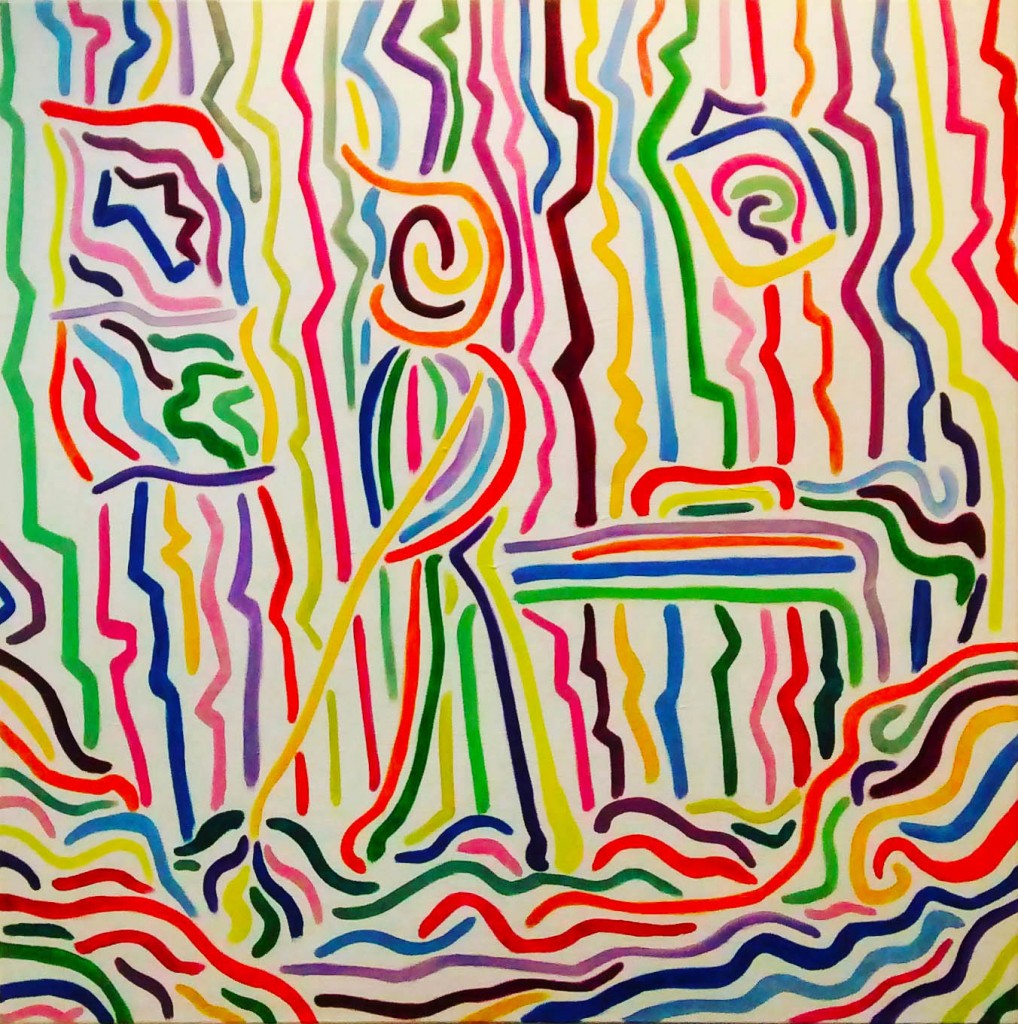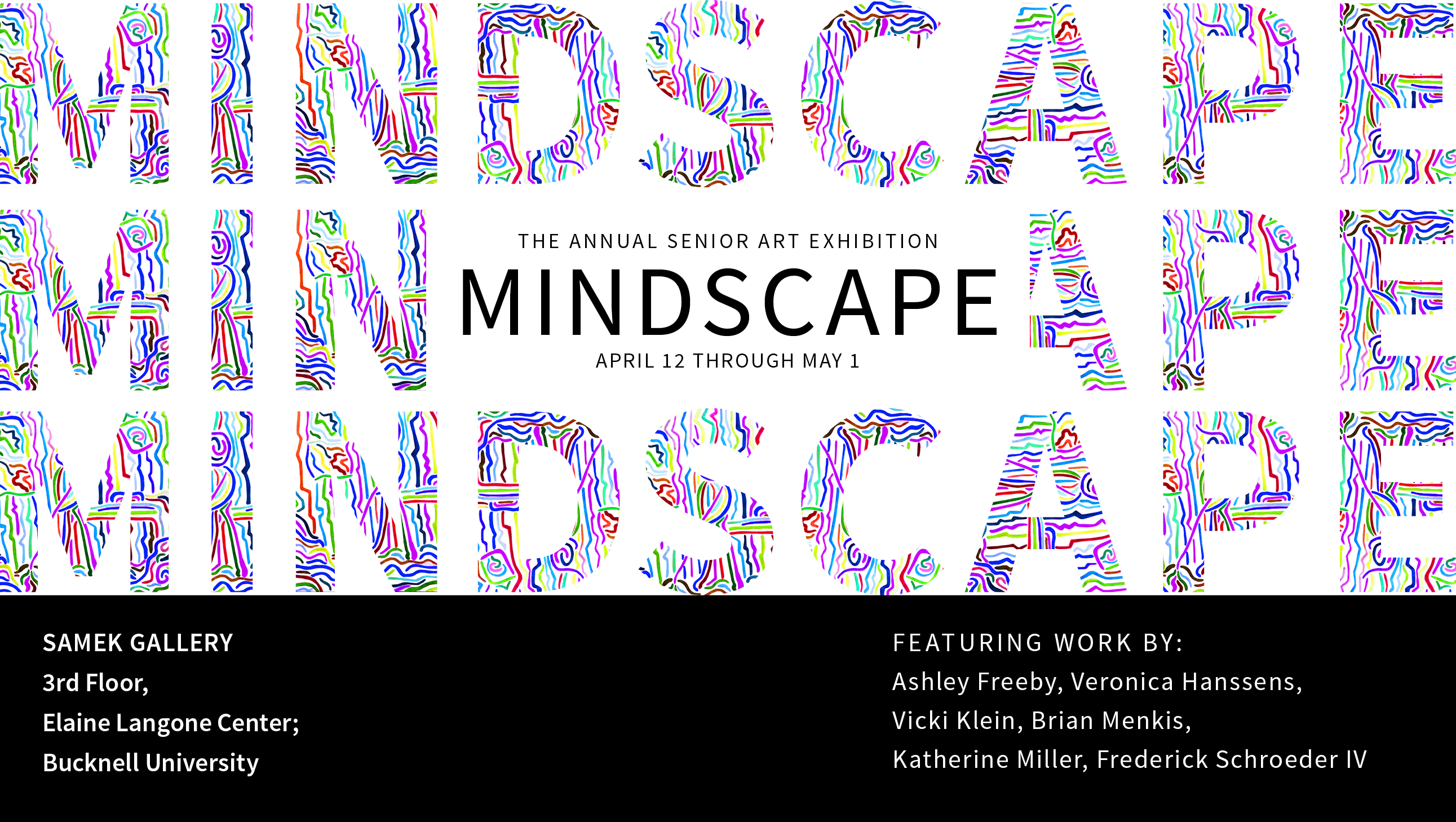April 12 – May 1
Samek Gallery, 3rd Floor Elaine Langone Center
Presented in partnership with the Art and Art History Department, this exhibition showcases culminating work by graduating senior Art majors and Art Assistants.
—
Related Events:
Opening Snap Talks and Reception
Friday, April 15, 5:30pm
Gallery Theater, 3rd Floor Elaine Langone Center
In partnership with Bucknell’s Department of Art and Art History, graduating seniors and Art Assistants will participate in a roundtable discussion of their work. A reception follows in the Samek Gallery.
The Gallery Engagement Team Presents: Spring Gala
Thursday, April 28, 5:30-7pm
Samek Gallery, 3rd Floor Elaine Langone Center
The Samek’s student organization, the Gallery Engagement Team, is throwing its spring gala at the Samek in celebration of the Annual Student Art Exhibition. This event is for students, by students.
“Come to the Samek Gallery in the ELC and check out the Spring Gala to view the senior art show, Mindscape, and the Gallery Engagement Team’s curated show, Brainland! Mindscape features installations of final projects from senior art students, and Brainland includes pieces that members of the Gallery Engagement Team have selected to visually represent the way their minds work. The event is on Thursday April 28th from 5:00 to 7:30, with plenty of mac and cheese bites, cupcakes, and cookies. There will be a portrait drawing station with pastel and notebooks, as well as surrealist masks to take photos with in front of the art. Hope to see you there!” -G.E.T.

Artist Statements:
A great man once said “I have not failed. I’ve just found 10,000 ways that won’t work” (Thomas Edison). Failure is a topic that seems to be ‘hush-hush’ in the world in which I live. Failure also rarely stands alone, and instead is seen as a necessity for understanding and appreciating success. In this work I examine myself, allowing my own failures to stand together, but not as a counterpart to success.
Failure, although rarely discussed as such, happens constantly in my peers lives as well as my own. Social failures, physical failures, academic failures, and even self care failures happen on a daily basis. In this work I state what specifically I have failed at. I speak directly to a camera in an uninhabited area to maintain the privacy of self reflection.
The goal of this work is not to criticize how failure is discussed in my culture, but instead is to share the vast amount of failures that happen in my own life. Through the process of verbalizing the things I have failed to complete or attain, I am able to consider how society has influenced me and my interpretations of successes and failures.
-Vicki Klein
As an art historian, I believe that art exists to serve the human condition, connecting and revealing everyday realities and ambitions. Art is an ancient protest, visual evidence of a constant dissent of the status quo. Art’s purpose is to serve society, provoke thought and encourage creative processes. My creative approach begins with grounded evidence from history. Through this process, I intend to spark a spiritual narrative curated from research of the past, realities of the present, and hopes for the future. To this end, human subjects are ideal candidates for my photography because they innately create identity. I intend to capture the ritual of identity behind every portrait.
We spend our lives assuming different roles. We fluctuate between our roles in the spheres of family, friendship, career and community, among others. These roles inform every moment of our day, between physical posture, language, and emotional intentions. Lifting the Veil explores the power inequities produced by stereotyped gender roles in our society. My intention is to expose the social blindness that obscure power discrepancies associated with gender. Through this exposition, I endeavor to elucidate the intrinsic value of the individual, which transcends preconceived social constructions of identity.
-Kate Miller
Not everyone grows out of having nightmares. I, for instance, grew into mine. I never had them as a child. Sleeping was a pleasant experience for me. I could rest soundly through the night and wake up feeling refreshed. Sleep was something I could look forward to at the end of a day of learning and play. That changed in highschool, when anxiety came into my life. During the daytime, this hardly made a difference. The anxiety tended to wait until bedtime to manifest itself in my dreamscape. Recurring nightmares would wake me up with a jolt throughout the night, often leaving me in a puddle of my own sweat.
Things only got worse in college. Increased stress levels that were minimally managed during the daytime would skyrocket as soon as I closed my eyes. I’d see the same scenes over and over again: returning to my old dojo for the black belt I never earned, chasing my dogs before they get hit by a car, reuniting with past acquaintances whom I’ve lost track of, never-ending messes that I need to clean, and my tumultuous interactions with my highschool track coach. The worst of these have caused me to experience the mysterious and frightening phenomenon known as sleep paralysis.
It’s no wonder why I was terrified to go to bed. I’d keep myself up for long hours, distracting myself with work just to avoid sleep and the vulnerability that came with it. But this was an unrealistic solution. It was suggested instead that I keep a dream journal. I’d keep notes on my dreams and even draw illustrative sketches. I soon realized I had enough material to write a memoir. Finally, I had a productive method of meditating on what these nightmares were all about, and a way to share them with others. It was a lot easier for me to show someone something I created than have to speak about it out loud. And yet, I found that by showing them the memoir, they were opening up to me about their own anxieties. I found that I wasn’t the only one, and these conversations made the nightmares occur less frequently. If I kept talking about the nightmares, using a combination of art and writing, I wondered how many more people I might reach. I made it my mission to eliminate my nightmares once and for all, through the process of creating.
-Frederick William Schroeder IV on Nightsweats
My work explores American history, culture and the systematic constructions of race to investigate a collective, more inclusive story about humans. In The Living Room, I pull imagery directly from historical events (slavery, civil rights, lynching) and discreetly place a representation of the images throughout the room. I do this to provoke thoughts of how blacks and whites have historically been divided. I tell this history within the walls of a biracial family’s living room as a meditation on historical division in an environment that symbolizes togetherness, oneness, and reconciliation.
As the artist, I often come back to the skin I live in. It is a site of complexity, a conjunction of emotions and contradictions of someone who is both white and black. My research led me to lynching and I questioned what my role as being biracial might have been during this time. Would I have been seen as Black? White? Would I have been accepted as being biracial? Standing between two worlds, I feel compelled to introduce an overlooked part of American history through the display of a number of definitions of the word ‘lynch-law’. Spanning a time-line from 1842 to the present, these eleven definitions move from the detailed and graphic to the more general, exemplifying the ways in which this history has been minimized and literally papered over.
-Ashley M. Freeby
These prints and drawings are visual excavations of subterranean worlds: tunnels, sewers, grottos, and the intricate web of underground infrastructure which fuels our cities and towns.
Less a study in the geology of the earth’s strata, this work is a dissection of our cultural landscape displayed in the form of vertical hierarchies. Here leisure reigns over labor, consumption over production; the empowered bask in sunlight while the disenfranchised toil in darkness.
The underground was once thought of as a conduit for traveling souls, where the sinful dead journey to spend bleak eternities. Today it is, among other things, a conduit for living navigators of those dripping municipal labyrinths we call subway systems.
The underground can also be a site for secret rituals, subterfuge, and subversive cultural movements. It is a rocky repository for memory and for the physical remnants of the past. Above ground, buildings and monuments are erected, celebrated, toppled, and subsequently forgotten and decomposed–creating fertile soil for new structures to follow suit.
These landscapes on paper explore a range of underworlds, irreverent visions of the geography of social stratification as well as chronologies of buried time. This work reminds us that despite our knowledge and understanding of the world around us, the realm of the unseen and unknown is vast; it sprawls in every direction.
-Veronica Hanssens
The work is a search for a “pure” sculptural language. It is pure in that the sculptural form is unidentifiable as anything but sculpture. Yet the work is laden with references to the forms of this world by which it attains meaning, negating the so-called purity. Rather than representing the visual form of other objects, the sculpture assumes their qualities in order to create intangible connections. Most fundamental of all these relationships is that of the sculpture and the body. This is not only a formal reference, but a relationship to the actual body of the viewer. Unlike a chair or table, which is defined by physical interaction, the sculpture is experienced primarily visually. Its lack of function and its separation via context (whether it be a pedestal or the gallery walls) serve to set it apart from other objects and the viewer. Yet the insistent physicality of the materials, and the fact that we can walk around it usurps the pure visuality of the sculpture. Thus it oscillates between an object for the mind and an object for the body. The sculpture’s complex relationship to the viewer makes us aware of the same contradiction of purpose within the human body. We are both spirit and flesh—two apparently opposite identities—yet we exist as one person. Sculpture makes us aware of this paradox by its own elusiveness of identity and purpose, enabling us to deepen our understanding of our relationship to ourselves, other persons, and the world we occupy.
-Brian Menkis

